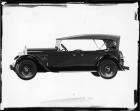|
282 versus 288 Packard engine
|
||||
|---|---|---|---|---|
|
Just can't stay away

|
Is there any difference between the 282 and 288 other than bore size?
The reason I ask is that this company below has a conversion kit to go from manual tranny to automatic. I want to convert my '41 120 to automatic transmission but prefer to retain the original Packard engine. The '41 has already been converted to 12-volt for installation of A/C. (Packard straight 8 owners can install a Chev 700R4/4L80E/2004R/350/400/or Powerglide transmission onto your motors! ) transmissionadapters.com/Packard%20to%20Chev%20adapter%20kit.htm Srt. 8 to Chev Auto 288/327 $895.00
Posted on: 2017/3/11 18:14
|
|||
|
||||
|
Re: 282 versus 288 Packard engine
|
||||
|---|---|---|---|---|
|
Forum Ambassador
|
I believe the Bendtsen adapter was not originally designed for changing a manual to an automatic but rather to replace the Ultramatic with a modern GM transmission. It could probably be used for the manual to automatic conversion but a question might be: is there room in the frame and tunnel for an automatic or would a lot of cutting and welding be necessary.
The blocks are different castings aside from bore size so the questions someone familiar with both engines would be asked to answer would be how and where the flywheel cover or bellhousing attaches on the 282 vs the 288/327. The flywheel housing numbers do not match between the 46-7 282 engines and the 48-50 288s but that could be due to factors other than attachment. The other question is the crankshaft flange where the flywheel or flex plates attach drilled the same on both engines. The engine half of the Ultramatic bellhousing removes from the 288/327 blocks and the Bendtsen conversion plate uses those bolt holes to attach. If the 282 manual flywheel cover has different spacing or the bolt locations change the center distance to the crankshaft the conversion plate would have to be reengineered. Same with the new crankshaft adapter and flex plate supplied with the conversion kit.
Posted on: 2017/3/11 18:59
|
|||
|
Howard
|
||||
|
||||
|
Re: 282 versus 288 Packard engine
|
||||
|---|---|---|---|---|
|
Home away from home
|
I've been corrected, there is many and varied differences between a 282 and a 288 engine. I have a 39 super 8 that now has a 1950 R 11 transmission and overdrive that bolted right up, no problems. I just wonder why Packard engineers made so many differences from a 282 to 288 - I remember reading they were very similar.
Posted on: 2017/3/11 23:59
|
|||
|
||||
|
Re: 282 versus 288 Packard engine
|
||||
|---|---|---|---|---|
|
Forum Ambassador

|
I remember reading they were very similar.
Well, they ARE similar, and also similar to the Oldsmobile and Pontiac L-head 8 cylinders as well as others; they are all of the same basic generic design philosophy. The departure from the 282 came about as Packard prepared for the new 22nd series and wanted an engine size for each of the new 8-cylinder car lines; for that they wanted a new engine size for the Super 8 between the 282 and the 356. They also saw the many economies of have all engines with the same piston bore and selected 3-1/2 for a common bore for the 282 replacement and the new Super 8 engine (the 245 Six and the 356 Custom 8 were already a 3-1/2 bore). An entirely new engine block was designed for the 288/327 family of engines to replace the 282 which was not capable of being bored to 3-1/2 inches and anyway was already getting long in the tooth.
Posted on: 2017/3/12 8:48
|
|||
|
||||
|
Re: 282 versus 288 Packard engine
|
||||
|---|---|---|---|---|
|
Home away from home
|
Silly me, after doing some quick research I was thinking of the 1935 120 motor that was 256.6 cubic inches which in 1936 and later went to 282 ci. The original poster asked about the 282 to the 288, which is a different animal. Mea culpa!
Posted on: 2017/3/12 14:55
|
|||
|
||||








